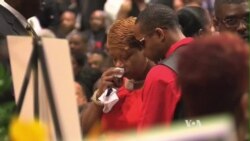That a white police officer fatally shot an unarmed black teenager in a central U.S. city on August 9, 2014, is undisputed.
More than three months later, however, whether Michael Brown's killing in Ferguson, Missouri, by police officer Darren Wilson will - or should - bring about new policies related to race and diversity remains undecided.
“The case is seen very differently whether you’re African-American or whether you’re white,” said Debbie Hines, a former state prosecutor turned trial lawyer who blogs about the case.
And the numbers support Hines. Eighty percent of black adults surveyed for the Pew Research Center in August - in the weeks after the shooting - believed the case raised important issues about race. Only one third of white respondents agreed.
Tension surrounding the case racheted up again Monday, when Missouri Governor Jay Nixon declared a state of emergency before a grand jury decision expected later this month about whether Wilson will be charged in Brown's fatal shooting.
Nixon said the order would activate the National Guard to assist state and local police in case of violence in Ferguson, a St. Louis suburb, when the grand jury's decision is announced.
Those who see race as a key issue in the teenager's death point to systemic problems. They want discrimination addressed on a national level.
The civil rights group NAACP has asked the U.S. Justice Department for “wholesale policy changes” to address police violence against black Americans.
The week after Brown’s death, the organization's Legal Defense Fund wrote a five-page letter to U.S. Attorney General Eric Holder, detailing 13 cases of what it called the “unjustified use of lethal and excessive force by police."
Among the NAACP's demands: more racial, ethnic and gender diversity in law enforcement, and more police officers who are members of the community they serve.
Holder has ordered an investigation into whether the Ferguson police department was involved in racial profiling and how the force handled the protests - which turned violent - after August 9. Authorities are also looking into how the force was trained.
But for now, it excludes looking at the hiring practices that made the Ferguson police department into an almost exclusively white force in a majority black city.
Elsie Scott, who has researched the interaction between police and minority communities, worked to increase the number of minorities in the New York City Police Department as Deputy Commissioner of Training.
She believes expanding the diversity of law enforcement agencies around the country is key to mending the rift communities of color feel separates them from police.
"Even when a cop is not violating the law, because of this distrust and this disconnect between the black community and the police, you can still end up with a major incident if you have not engaged your community, or if you do not have black people in your police department," said Scott, now director of the Ronald W. Walters Leadership and Public Policy Center at Howard University in Washington.
For her, treating cases like Brown's as isolated incidents stands in the way of understanding larger issues across the country.
"I think a lot of people will dismiss this and say, ‘well my city is not like Ferguson. We don’t have the prejudice that seems to be there in Ferguson, we have proper protocols,' Scott said. "And I think that’s a disservice because if you think your city doesn’t have problems, then you’re going to be somewhat like Ferguson if you end up with an incident like this."
Bill Johnson heads an umbrella organization in Washington that represents about a quarter-million police officers and their unions through the National Association of Police Organizations. He sees the shooting primarily as a question of whether Wilson was defending himself, therefore justified in his use of force against Brown, who was shot at least six times after an altercation with the officer.
"Like it or not, regardless of the color of the people involved, regardless of the socio-economic standards or regardless of the history of the police department, for an individual officer, if his or her life is threatened, or if they reasonably believe it’s threatened, they have the right to use force," said Johnson.
He disagreed with Scott that putting more police from minority communities in areas similar to their cultural or racial background is a solution to bridging the perceived gap seen by communities of color between them and the police.
"If you pursue that and it goes too far down that road, it really ends up with a kind of insidious discrimination that’s there. And I think that...doesn’t solve the problem," said Johnson.
"I think if you send a message also that, to a community of color, you can’t trust the white officer. You can’t trust the Anglo officer. We’re sending people of color into a community because we can’t - you know, that’s really the only people you can trust," he added.
Instead, Johnson supports training and the creation of community liaisons on the police force, where officers get to know the area they patrol by interacting more with residents.
The wait to see whether Brown’s death will change what some Americans believe is an unacceptable status quo may take a lot longer than the grand jury decision expected by the end of November.
"There’s a lot of healing that’s going to have to come about," said Scott, who recalled the civil rights protests of the 1960s that eventually lead to policy reforms.
"It’s not going to happen overnight."










